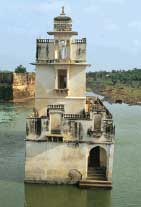Ancient Indians understood the science and art of settlement planning, architecture and governance of natural resources. British gazettes speak of these systems at length calling us a hydraulic society. Indus Valley civilization is a great example of that.Highly sophisticated systems were in place which varied to suit different ecosystems, for harvesting every drop of water.
I’ll try to traverse through history, and tell you how water harvesting has been there since centuries.
Dholavira in Gujarat, an Indus Valley Civilization site, had lakes built in to collect monsoon run-off, bunds and inlet channels to divert water, and intricate drainage system for storm water, drinking water. Similar evidences have been found at Mohanjodaro and Harappa.
Towards the end of 1st century BC, the Sringaverapura tank near Allahabad is a remarkable system to take the floodwater of Ganga into a set of desilting chambers, including water weirs, to clean the water for drinking. It is a unique example of hydraulic engineering. 
The importance of water governance was well understood in ancient India. Kautilya’s Arthasastra has details of how tanks and canals are to be built and managed. The key was to clarify the enabling role of the state – the king – and the management role of local communities. The kings did not have engineers from IIT. They provided fiscal incentives to communities and individuals who built water systems.
Lake and well irrigation, tanks , anicuts ( Cauvery Anicut ) developed on a large scale during the time of Pandya, Chera and Chola dynasties in south India (1st-3rd Century A.D.) . Large structures were built across Cauvery and Vaigai rivers.
Mohammad Bin Tughlaq encouraged the farmers to build their own rain water harvesting systems and wells. Feroze Shah Tughlaq built the Western Yamuna Canal to extend irrigation facilities in the dry land tracts of the present-day Haryana and Rajasthan. Abdul Rahim Khan built a unique water supply system in Burhanpur, M.P. It had long lines of underground tunnels with vertical airshafts to tap the underground water flow from the nearby Satpura hill ranges to the Tapi river lower down. The system is still functioning well. Shahjahan built many canals like the Bari Doab or the Hasli Canal.
Vijaynagar Kingdom in the south took keen interest in building storage tanks and dams.
All forts, built in different terrains and climatic conditions, had elaborate arrangements for drinking water. Amber Fort, Jodhpur Fort, Chittor Fort are prime examples of this.
Let us have a look at the different kinds of local water harvesting practices that were used to conserve water.
Taalab/ Bandhis/Samand – Reservoirs
- Natural, such as ponds or man-made lakes
- Served the purpose of irrigation and drinking.
- When the water in these reservoirs dried up, the pond beds were used for cultivation.

Johads
- Small earthen check dams built in Rajasthan to capture and conserve rainwater, thus improving percolation and recharging ground water.
Baoris / Bers
- Very old community wells in Rajasthan used mainly for drinking.
- Built by banjaras for their drinking water needs.
- Could hold water for a long time because of almost negligible water evaporation.
,%20Todarai%20Singh/HADI%20RANI-KA-KUND.jpg)
Jhalaras
- Man-made tanks in Rajasthan and Gujarat, essentially meant for community use and for religious rites but not for drinking.
Step Wells or Water Temples
- Used for harvesting rainwater and providing water for drinking purpose in arid parts. It is famously called water temple.
- Initiated due to the need to ensure water supply during the period of drought.
- Recall, Rani ki vav stepwell at Patan, Gujarat was added to the list of UNESCO World Heritage sites recently. Check the photo below.
Other prominent water harvesting practices were kunds, kuis etc.
All this indicates that we have had a glorious tradition of water harvesting by the village communities with the encouragement from the state. This history reflects the ingenuity and wisdom of the people in ancient India who made harvesting of water and its management an integral part of the native culture and community life. We can learn some lessons in the present, for a better future.
Leave a Reply